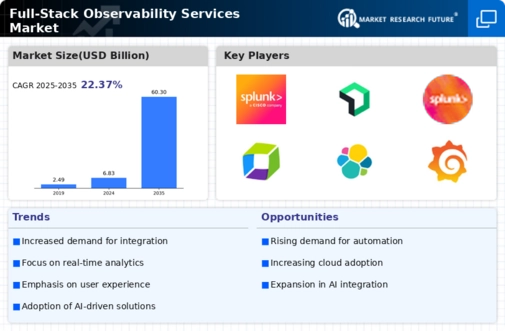Market Growth Projections
The Global Full-Stack Observability Services Market Industry is poised for substantial growth, with projections indicating a market size of 6.83 USD Billion in 2024 and an anticipated increase to 60.3 USD Billion by 2035. This growth trajectory suggests a compound annual growth rate (CAGR) of 21.88% from 2025 to 2035. Such figures reflect the escalating demand for comprehensive observability solutions as organizations seek to enhance operational efficiency and user experience. The market's expansion is likely driven by technological advancements and the increasing complexity of IT environments.
Focus on Enhanced User Experience
Enhancing user experience remains a critical driver within the Global Full-Stack Observability Services Market Industry. Organizations are increasingly aware that application performance directly impacts customer satisfaction and retention. As such, there is a concerted effort to implement observability solutions that provide insights into user interactions and application behavior. By understanding user journeys, businesses can identify bottlenecks and optimize performance. This focus on user experience is likely to propel market growth, as companies invest in tools that facilitate a seamless and responsive digital experience.
Integration of AI and Machine Learning
The integration of artificial intelligence and machine learning into observability services is transforming the Global Full-Stack Observability Services Market Industry. These technologies enable predictive analytics, anomaly detection, and automated incident response, enhancing the overall efficiency of IT operations. By leveraging AI, organizations can analyze vast amounts of data to identify patterns and potential issues before they escalate. This proactive approach not only reduces downtime but also optimizes resource allocation. As a result, the market is expected to witness a robust growth trajectory, with a projected CAGR of 21.88% from 2025 to 2035.
Rising Demand for Real-Time Monitoring
The Global Full-Stack Observability Services Market Industry experiences a notable surge in demand for real-time monitoring solutions. Organizations increasingly recognize the necessity of maintaining operational efficiency and minimizing downtime. This trend is driven by the need for immediate insights into application performance and user experience. As businesses migrate to cloud environments, the complexity of monitoring increases, necessitating advanced observability tools. The market is projected to reach 6.83 USD Billion in 2024, reflecting a growing investment in technologies that provide comprehensive visibility across entire tech stacks.
Increased Complexity of IT Environments
The increasing complexity of IT environments significantly influences the Global Full-Stack Observability Services Market Industry. As organizations adopt multi-cloud strategies and microservices architectures, the need for comprehensive observability becomes paramount. Traditional monitoring tools often fall short in providing the necessary visibility across diverse platforms and services. Consequently, businesses are turning to full-stack observability solutions that offer end-to-end insights. This shift is anticipated to drive market growth, with projections indicating a rise to 60.3 USD Billion by 2035, as companies seek to manage their intricate IT ecosystems effectively.
Regulatory Compliance and Security Concerns
Regulatory compliance and security concerns are pivotal factors shaping the Global Full-Stack Observability Services Market Industry. With the rise of data protection regulations, organizations must ensure that their IT systems comply with legal standards while maintaining security protocols. Observability services play a crucial role in monitoring compliance and identifying potential vulnerabilities. As businesses navigate complex regulatory landscapes, the demand for comprehensive observability solutions that address both compliance and security needs is expected to grow. This trend underscores the importance of investing in observability tools that provide visibility into security postures and compliance status.
























Leave a Comment